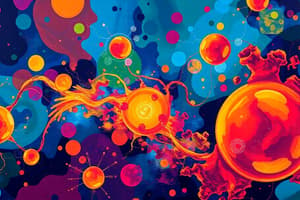Podcast
Questions and Answers
Match the following energy types with their definitions:
Match the following energy types with their definitions:
Potential Energy = Stored energy Kinetic Energy = Energy of motion Chemical Energy = Energy stored in chemical bonds Thermal Energy = Energy related to temperature
What is metabolism?
What is metabolism?
The set of life-sustaining chemical reactions in organisms.
Which law states that energy cannot be created or destroyed?
Which law states that energy cannot be created or destroyed?
Exergonic reactions require energy input to proceed.
Exergonic reactions require energy input to proceed.
Signup and view all the answers
What is phosphorylation?
What is phosphorylation?
Signup and view all the answers
What is the function of an enzyme's active site?
What is the function of an enzyme's active site?
Signup and view all the answers
What is allosteric regulation?
What is allosteric regulation?
Signup and view all the answers
Study Notes
Metabolism and Energy
- Metabolism is the sum of all chemical reactions that occur in an organism.
- Catabolic pathways break down complex molecules into simpler ones, releasing energy.
- Anabolic pathways build complex molecules from simpler ones, requiring energy.
- Energy can exist in various forms: potential, kinetic, chemical, thermal.
- Thermodynamics is the study of energy transformations.
- The first law of thermodynamics states that energy cannot be created or destroyed, only transformed.
- The second law of thermodynamics states that every energy transformation increases the disorder (entropy) of the universe.
Free Energy and Reactions
- Free energy is the energy available to do work.
- Exergonic reactions release energy, having a negative free energy change.
- Endergonic reactions require energy, having a positive free energy change.
ATP and Energy Coupling
- Chemical work drives the synthesis of molecules.
- Transport work pumps substances across membranes.
- Mechanical work powers movement.
- Phosphorylation is the addition of a phosphate group to a molecule, often using ATP.
- ATP is a central molecule in energy coupling, transferring energy from exergonic to endergonic reactions.
Enzymes and Activation Energy
- Enzymes are biological catalysts that speed up reactions without being consumed.
- Activation energy is the minimum energy required for a reaction to occur.
- Enzymes lower activation energy by providing an alternative reaction pathway.
- The enzyme-substrate complex is formed when a substrate binds to the active site of an enzyme.
- Competitive inhibitors bind to the active site, blocking the substrate.
- Noncompetitive inhibitors bind to a different site on the enzyme, changing its shape and activity.
- Cofactors include non-protein helpers that assist enzyme function, including coenzymes.
- Induced fit is the change in enzyme shape upon substrate binding.
Enzyme Regulation
- Allosteric enzymes have multiple binding sites, affecting enzyme activity.
- Allosteric activators increase enzyme activity.
- Allosteric inhibitors decrease enzyme activity.
- Cooperativity is a form of allosteric regulation where binding of one substrate molecule affects the binding of others.
- Feedback inhibition occurs when the end product of a metabolic pathway inhibits an enzyme earlier in the pathway.
Studying That Suits You
Use AI to generate personalized quizzes and flashcards to suit your learning preferences.
Related Documents
Description
Explore the intricate world of metabolism and energy transformations in living organisms. This quiz covers key concepts such as catabolic and anabolic pathways, thermodynamics, free energy, and the role of ATP in energy coupling. Test your understanding of how energy is utilized and transformed to sustain life.





